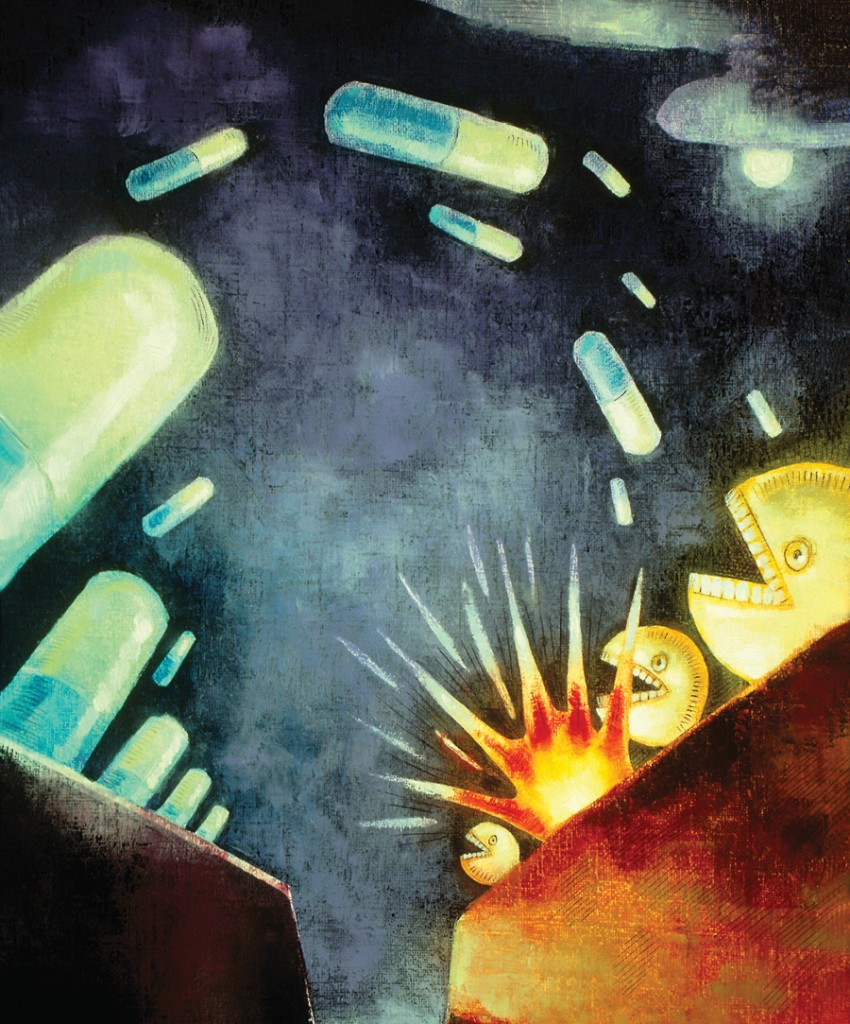
New Wave of ‘Superbugs’ Poses Dire Threat | Deadly Bacteria That Resist Strongest Drugs Are Spreading | Drug-Resistant Bacteria and Lack of New Antibiotics Could Signal Catastrophe
We’ve all seen the ominous headlines—and heard the warnings from our own health care providers—about the dangers of antibiotic overuse. But now for some good news: It turns out that when bacteria become drug-resistant, they go through a process that could actually provide a powerful tool for discovering new drugs.
Traditionally, bacteria have been the source of important drugs such as antibiotics and anticancer agents. Researchers looking for new bacterially synthesized drugs have long known that bacterial genomes contain a large number of “silent genes” that contain the instructions for making drug-like compounds. Until now, though, scientists have found it very difficult to identify ways to turn on the production of these compounds, known as secondary metabolites.
Vanderbilt biochemists Brian Bachmann and John McLean were investigating how bacteria develop drug resistance when they discovered that strains of antibiotic-resistant bacteria express hundreds of compounds not produced by their progenitors—many of which are potential secondary metabolites.
“It’s as if the bacteria respond to the assault by the antibiotic with a ‘save-all-ships’ strategy of turning on hundreds of silent genes,” explains Bachmann, associate professor of chemistry and biochemistry.
The Vanderbilt researchers’ findings, reported in January in the Online Early Edition of the Proceedings of the National Academy of Sciences, should give a major boost to natural products drug discovery—the process of finding new drugs from compounds isolated from living organisms—by substantially increasing the number of novel compounds scientists can extract from individual microorganisms.
“This technique is something like fracking in the natural gas industry,” says Bachmann. “We’d known for a long time that there were large amounts of underground natural gas we couldn’t extract using conventional methods, but now we can, using hydraulic fracturing technology. In a similar fashion we think we can use bacteria’s antibiotic resistance to intensively mine the bacterial genome for new drug leads.”
Bachmann is an expert in natural products drug discovery, and McLean, an assistant professor of chemistry, is a pioneer in the development of analytical instrumentation and chemical techniques that can identify thousands of different biological compounds simultaneously, such as ion mobility-mass spectrometry. The original purpose of their study was to take the most detailed look yet at what happens when microbes develop drug resistance.
“One of the daunting challenges is to rapidly inventory the tens to hundreds of thousands of molecules the bacteria construct to live, and then to read this inventory to understand how the bacteria compensate for their changing circumstances,” says McClean. “To complicate matters further, we are looking for new drug-like molecules, so by definition we are looking for something that has not been seen before.”
Working with Research Assistant Dagmara Derewacz and graduate students Cody Goodwin and Ruth McNees, Bachmann and McLean started with the well-characterized soil bacterium Nocardiopsis. They exposed the bacterium to two different antibiotics—streptomycin and rifampicin—and observed the results.
“The first thing that happens is almost all the bacteria die. Less than one cell in a million survives,” says Bachmann.
The chemists then cultured the survivors (six streptomycin-resistant strains and five rifampicin-resistant strains) without the antibiotic and used McLean’s instrumental methods to profile the drug-like compounds they produced.
The differences turned out to be much greater than they expected. Survivors had undergone extensive mutations—not only in the genes that produce secondary metabolites, but also in the housekeeping genes that alter the way they make RNA and proteins. As a result, the resistant strains produced more than 300 compounds not expressed by the original organism.
“The cells appear to be ‘de-repressing’ as many of their silent genes as possible,” Bachmann says. “This seems like a very drastic way to become drug-resistant.”
McLean’s team members have developed strategies allowing them to automatically identify and compare the relative uniqueness and relative abundance of tens of thousands of molecules from which the hundreds of novel compounds were found. “What we are looking for are new species of molecules in the mutants that are the most unique and the most abundant,” says Bachmann.
In the antibiotic-resistant Nocardiopsis strains, researchers found a total of five compounds that were both unique enough and abundant enough to isolate, determine their molecular structures, and test for biological activity.
“Normally, we only find one compound per organism,” says Bachmann, “so this is a significant improvement in yield, allowing us to get many new compounds from previously mined microorganisms.”
Read more about Vanderbilt’s drug discovery efforts.